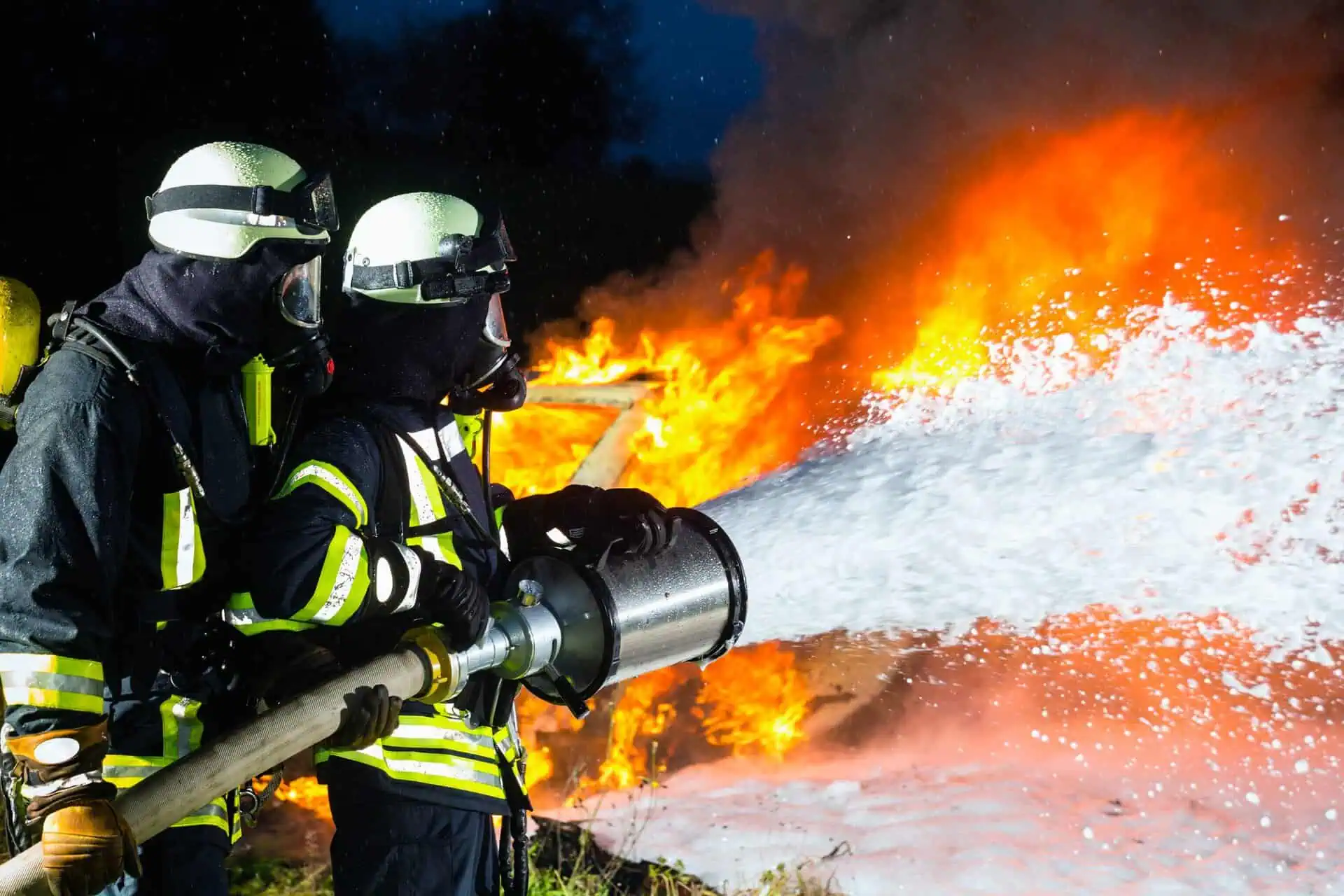AFFF Neuroendocrine Tumors Lawsuit: Analyzing Studies
- Last Updated: July 14th, 2025

Attorney Jessica Paluch-Hoerman, founder of TruLaw, has over 28 years of experience as a personal injury and mass tort attorney, and previously worked as an international tax attorney at Deloitte. Jessie collaborates with attorneys nationwide — enabling her to share reliable, up-to-date legal information with our readers.
Legally Reviewed
This article has been written and reviewed for legal accuracy and clarity by the team of writers and legal experts at TruLaw and is as accurate as possible. This content should not be taken as legal advice from an attorney. If you would like to learn more about our owner and experienced injury lawyer, Jessie Paluch, you can do so here.
Fact-Checked
TruLaw does everything possible to make sure the information in this article is up to date and accurate. If you need specific legal advice about your case, contact us by using the chat on the bottom of this page. This article should not be taken as advice from an attorney.
Key takeaways:
- AFFF contains PFAS chemicals that have been linked to neuroendocrine tumors.
- Multiple studies have shown a connection between AFFF exposure and increased risk of developing neuroendocrine tumors.
- Those diagnosed with neuroendocrine tumors after AFFF exposure may qualify to file an AFFF lawsuit and seek compensation.
Overview of the AFFF Neuroendocrine Tumors Lawsuit
On this page, we’ll provide an overview of the AFFF Neuroendocrine Tumors Lawsuit, the link between AFFF exposure and neuroendocrine tumors, who qualifies to file an AFFF cancer lawsuit, and much more.
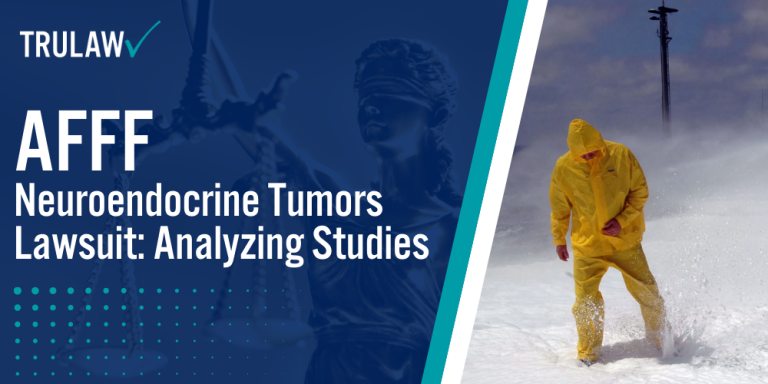
Intro To AFFF Neuroendocrine Tumors Lawsuits
Aqueous Film Forming Foam (AFFF) is a fire suppressant that contains harmful chemicals known as PFAS. Exposure to these chemicals has been linked to various health issues, including neuroendocrine tumors.
Studies have shown a connection between AFFF exposure and neuroendocrine tumors:
- A study published in the International Journal of Environmental Research and Public Health found that firefighters exposed to AFFF had a higher risk of developing neuroendocrine tumors.
- Another study in the Journal of Occupational and Environmental Medicine reported an increased incidence of neuroendocrine tumors among workers in PFAS manufacturing facilities.
- The Agency for Toxic Substances and Disease Registry (ATSDR) has also acknowledged the potential link between PFAS exposure and neuroendocrine tumors.
If you or a loved one has been diagnosed with neuroendocrine tumors after exposure to AFFF, you may be eligible to file an AFFF lawsuit.
Contact TruLaw for a free consultation using the chat on this page to receive an instant case evaluation.
Table of Contents
AFFF Neuroendocrine Tumor Lawsuit: Claimant Stories
The narratives of individuals who developed neuroendocrine tumors as a result of exposure to aqueous film-forming foam (AFFF) are central to firefighting foam cancer lawsuits.
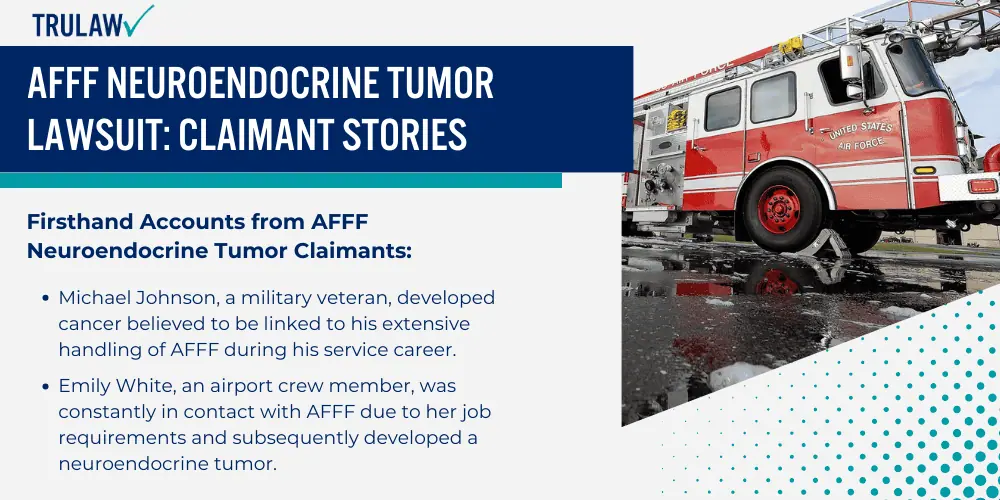
Their experiences underscore the gravitas of personal injury claims and the demand for just AFFF foam cancer lawsuit settlements.
Firsthand Accounts from AFFF Neuroendocrine Tumor Claimants
The personal injury claims arising from AFFF exposure tell a story of struggle and the pursuit of justice.
Each account details the moment of receiving a pancreatic cancer diagnosis, the challenges faced during treatment, and the impact on the claimants’ lives.
Firsthand Accounts from AFFF Neuroendocrine Tumor Claimants:
- Michael Johnson, a military veteran, developed cancer believed to be linked to his extensive handling of AFFF during his service career.
- Emily White, an airport crew member, was constantly in contact with AFFF due to her job requirements and subsequently developed a neuroendocrine tumor.
Each claimant’s experience adds a unique perspective to the collective fight in AFFF foam lawsuits against the manufacturers for failing to warn about the carcinogenic effects of the foam.
The Human Impact of AFFF on Neuroendocrine Tumor Sufferers
The AFFF firefighting foam lawsuit is not just a legal battle—it’s about individuals who have suffered immensely.
The stories behind these foam cancer lawsuits are the driving force behind seeking accountability and compensation.
Here’s a look at the profound impact AFFF exposure can have:
- Trauma: Each plaintiff copes with the trauma of a life-changing cancer diagnosis.
- Financial Strain: The cost of treating neuroendocrine tumors has led to financial hardship for many affected families.
- Lifestyle Alterations: The onset of kidney cancer has forced sufferers to change their day-to-day lives dramatically.
- Emotional Toll: The emotional distress from dealing with cancer and the legal process can be overwhelming.
These individuals are not just claimants in a lawsuit; they are people who have had their lives upended by a disease that may have been preventable had there been adequate warnings about the dangers of AFFF.
Scientific Evidence in AFFF Neuroendocrine Tumors Litigation
Litigation concerning neuroendocrine tumors linked to AFFF (aqueous film-forming foam) is underpinned by scientific evidence demonstrating connections between PFAS exposure and tumor development.
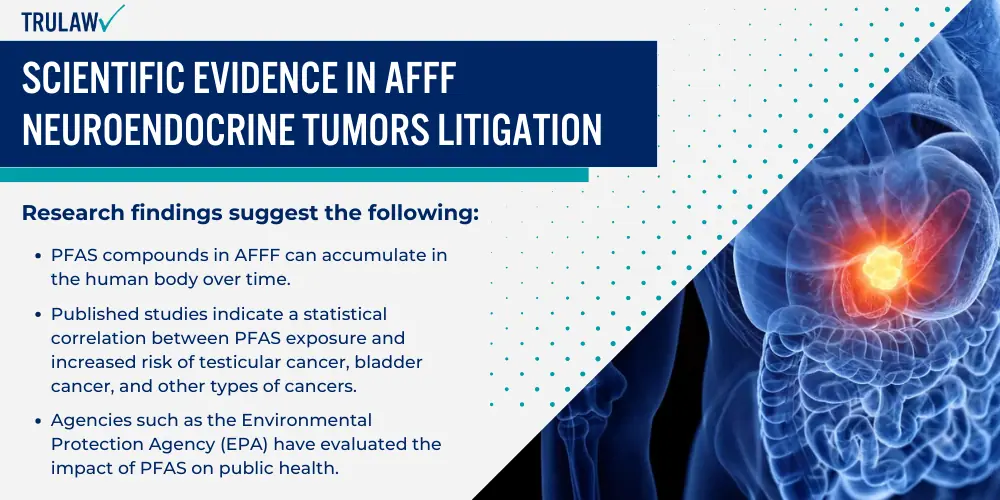
Key testimony relies on research studies and expert analysis.
Research Correlating AFFF to Neuroendocrine Tumor Development
PFAS, or per- and polyfluoroalkyl substances, are a group of forever chemicals historically used in AFFF.
This firefighting foam has been essential in suppressing fuel fires, particularly in military and aviation contexts.
Recent scientific inquiry sheds light on the potential consequences of PFAS exposure, including the risk of developing neuroendocrine tumors.
Research findings suggest the following:
- PFAS compounds in AFFF can accumulate in the human body over time.
- Published studies indicate a statistical correlation between PFAS exposure and increased risk of testicular cancer, bladder cancer, and other types of cancers.
- Agencies such as the Environmental Protection Agency (EPA) have evaluated the impact of PFAS on public health.
- While causal links are still being investigated, the persistence of these substances in the environment and body raises long-term health concerns.
Expert Testimonies in AFFF Neuroendocrine Tumor Cases
Expert testimonies are imperative in AFFF litigation, establishing the connection between AFFF exposure and the development of neuroendocrine tumors.
Well-versed in both the chemical properties of AFFF and the medical aspects of neuroendocrine tumors, experts aim to elucidate the complex relationship between exposure and disease.
Critical aspects covered in testimonies include:
- Detailed explanation of how PFAS compounds interact with the body’s endocrine system.
- Assessment of individual exposure levels and durations in plaintiffs.
- Interpretation of epidemiological data and medical histories against the backdrop of PFAS research.
- The comparative analysis of neuroendocrine tumor rates in populations with high levels of PFAS exposure.
Legal Framework of AFFF Neuroendocrine Tumors Claims
Within the legal landscape, individuals who developed neuroendocrine tumors potentially linked to Aqueous Film-Forming Foam (AFFF) may seek compensation through litigation.
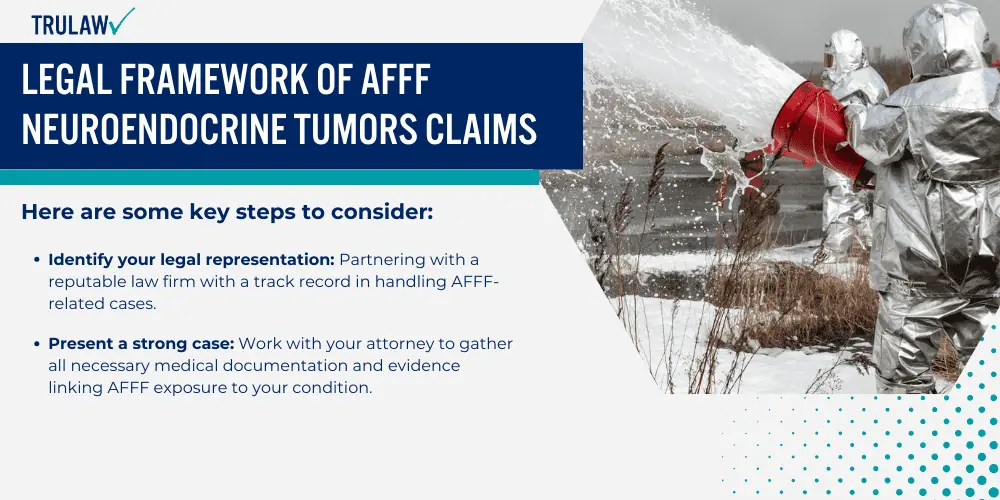
This section breaks down the legal recourse available and specific timelines relevant to these claims.
Navigating the Legal System for AFFF Tumor Litigations
The AFFF litigation process may seem intricate at first, but taking decisive, informed steps can aid individuals in seeking justice.
First and foremost, engaging a knowledgeable law firm that specializes in environmental toxic tort cases is critical.
These firms often have dedicated firefighting foam cancer lawyers or firefighting foam attorneys well-versed in the science and legal precedent surrounding these cases.
Here are some key steps to consider:
- Identify your legal representation: Partnering with a reputable law firm with a track record in handling AFFF-related cases.
- Class action participation: Determine if joining an AFFF MDL (Multi-District Litigation) is a suitable course of action.
- Present a strong case: Work with your attorney to gather all necessary medical documentation and evidence linking AFFF exposure to your condition.
- Prepare for litigation: Depending on the case, you may have to testify or provide a deposition in the lawsuit.
Personal injury lawyers may also advise on the eligibility to file for an individual lawsuit versus joining a class action, depending on the specifics of the case.
Statutes of Limitations in AFFF Neuroendocrine Tumor Lawsuits
For any legal claim, including those relating to AFFF and neuroendocrine tumors, statutes of limitations are a vital component.
This defines the timeframe within which a afff class action lawsuit must be filed before the right to claim expires.
Key considerations to avoid missing the deadline for filing an AFFF lawsuit:
- Review relevant laws: Each state has its own time limits for filing a claim, and it’s crucial to understand these as they apply to your case.
- File promptly: Ensure the lawsuit is filed within the time limits to avoid forfeiture of the right to seek compensation.
- Consult with experts: An AFFF litigation specialist can provide guidance on navigating the specific deadlines relevant to your claim.
- Understand exceptions: In some instances, there may be extensions or tolling of the limitations period, which legal experts can help identify.
Utilizing the expertise of experienced personal injury lawyers will help ensure that claims are filed within the appropriate statutes of limitations, allowing claimants to pursue their rights effectively.
The Role of Attorneys in AFFF Neuroendocrine Tumors Disputes
In AFFF neuroendocrine tumors disputes, attorneys play a pivotal role in guiding clients through the legal landscape and ensuring that their rights are protected throughout the litigation process.
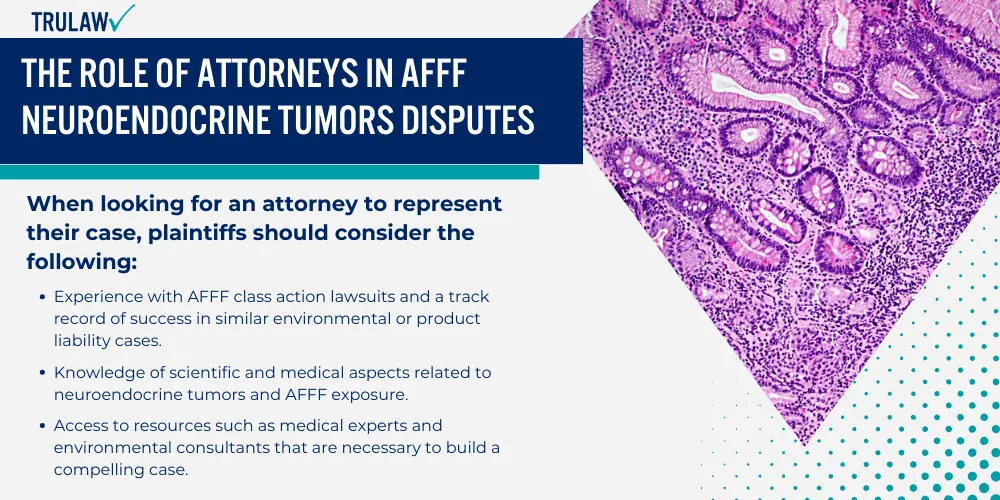
Selecting Competent Representation for AFFF Tumor Lawsuits
Finding the right lawyer is crucial for navigating the complexities of an AFFF lawsuit.
Ideal candidates will possess both specialized knowledge and a client-centered approach.
When looking for an attorney to represent their case, plaintiffs should consider the following:
- Experience with AFFF class action lawsuits and a track record of success in similar environmental or product liability cases.
- Knowledge of scientific and medical aspects related to neuroendocrine tumors and AFFF exposure.
- Access to resources such as medical experts and environmental consultants that are necessary to build a compelling case.
- Ability to empathize and communicate clearly with clients, helping them understand each stage of the lawsuit.
Strategy Development in AFFF Neuroendocrine Tumors Litigation
Building a winning AFFF lawsuit requires a meticulously crafted legal strategy.
This involves a multi-step approach to ensure a strong foundation for your case.
Developing a legal strategy in AFFF firefighting foam lawsuits involves the following key steps:
- Reviewing all medical records and exposure history to link AFFF to the development of neuroendocrine tumors.
- Gathering evidence of negligence, such as failure to warn of the dangers associated with AFFF or breaches in safety protocols.
- Analyzing previous AFFF firefighting foam cases to inform the approach for the current lawsuit.
- We outline a timeline and roadmap to manage the litigation’s lifecycle, from discovery to potential settlement or trial.
Settlements and Verdicts in AFFF Neuroendocrine Tumor Cases
In examining the landscape of legal outcomes, one finds that settlements and verdicts in AFFF Neuroendocrine tumor cases have set significant precedents for impacted parties.
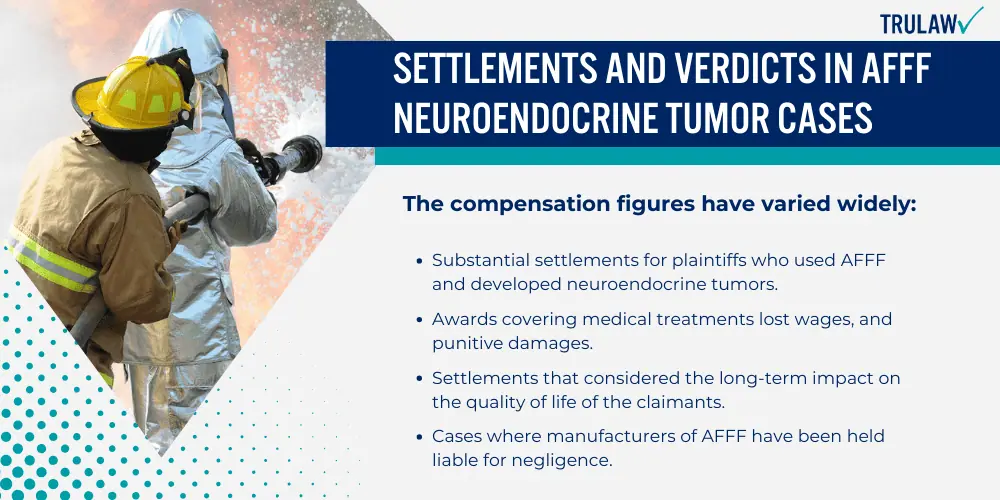
This section details historical payouts and recent trends in lawsuit outcomes.
Historical Compensation in AFFF Tumor Litigation
Lawsuit settlements involving AFFF (aqueous film-forming foam) and related neuroendocrine tumors have historically been influenced by factors such as exposure levels, the severity of the condition, and the legal arguments presented.
The compensation figures have varied widely:
- Substantial settlements for plaintiffs who used AFFF and developed neuroendocrine tumors.
- Awards covering medical treatments lost wages, and punitive damages.
- Settlements that considered the long-term impact on the quality of life of the claimants.
- Cases where manufacturers of AFFF have been held liable for negligence.
The monetary compensation can serve both as a punitive measure against negligent manufacturers and as financial support for the affected individual’s medical expenses and suffering.
Trends in AFFF Neuroendocrine Tumors Lawsuit Outcomes
The trends in lawsuit outcomes for AFFF-related neuroendocrine tumors suggest evolving legal interpretations and scientific understanding of the health impacts of exposure to firefighting foams.
Recent cases highlight:
- A growing propensity toward reaching settlements before trial.
- The use of multidistrict litigation (MDL) to streamline the legal process.
- Increasing awareness of the dangers of AFFF leads to more comprehensive settlements.
- A tendency towards favoring the plaintiffs’ side given the accrual of scientific evidence.
It is clear that each firefighting foam lawsuit settlement reflects the growing body of research linking AFFF to health risks and the evolving regulatory stance on these compounds.
Managing Medical Costs from AFFF-Linked Neuroendocrine Tumors
Managing the financial impact of AFFF-linked neuroendocrine tumors can be a daunting aspect for patients and their families.
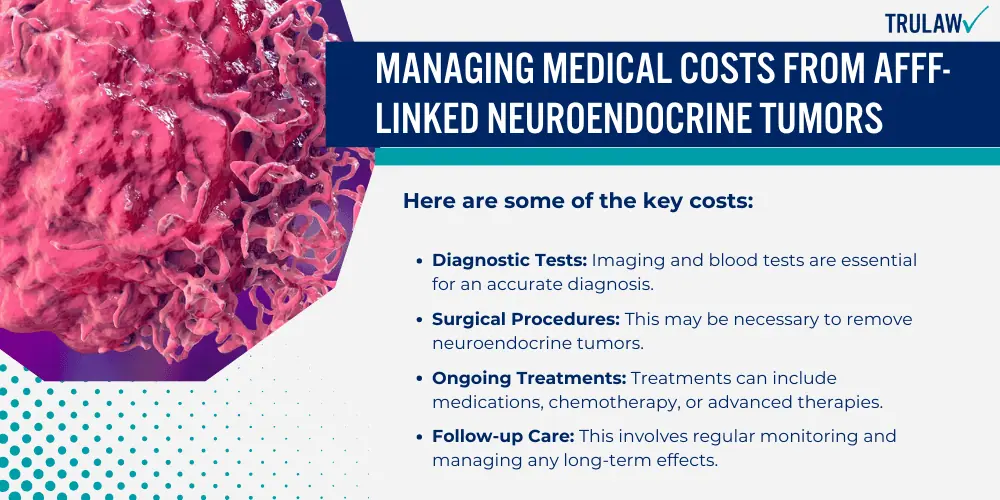
The costs can be substantial, ranging from direct medical expenses to indirect financial burdens.
Financial Burdens of AFFF-Related Neuroendocrine Tumors
The financial implications for patients with neuroendocrine tumors associated with Aqueous Film Forming Foams (AFFF) include a range of medical expenses.
Here are some of the key costs:
- Diagnostic Tests: Imaging and blood tests are essential for an accurate diagnosis.
- Surgical Procedures: This may be necessary to remove neuroendocrine tumors.
- Ongoing Treatments: Treatments can include medications, chemotherapy, or advanced therapies.
- Follow-up Care: This involves regular monitoring and managing any long-term effects.
Insurance and AFFF Neuroendocrine Tumor Healthcare Claims
Insurance coverage is critical for managing medical costs but can be complex for conditions like AFFF-related neuroendocrine tumors.
Here’s what patients should consider:
- Examine the insurance policy to understand what is covered, including procedures, medications, and long-term care.
- Communicate with health insurance providers to ensure all eligible medical expenses are claimed.
- Keep meticulous records of all treatments, medications, and related expenses for insurance claims.
- Be aware of the appeals process in case insurance claims for treatment costs related to AFFF exposure are initially denied.
Neuroendocrine tumors require a treatment approach tailored to the patient, which can mean varying medical expenses depending on the treatment plan.
Insurance policies can help alleviate some of the financial strain, but it is important for patients to understand and advocate for the coverage of these specific tumor treatments.
The Future of AFFF Neuroendocrine Tumors Legal Actions
The legal landscape regarding AFFF neuroendocrine tumor claims is expected to evolve as ongoing research sheds new light on the links between AFFF exposure and prostate cancer development.
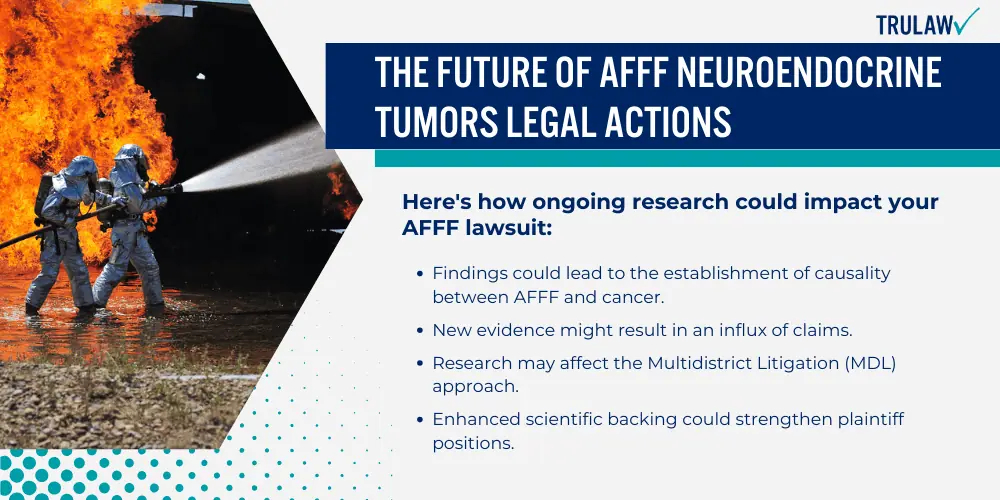
Ongoing Research Impacting AFFF Tumor Legal Claims
Researchers continue to investigate the relationship between aqueous film-forming foam (AFFF) and neuroendocrine tumors, which may significantly influence current AFFF lawsuits.
Here’s how ongoing research could impact your AFFF lawsuit:
- Findings could lead to the establishment of causality between AFFF and cancer.
- New evidence might result in an influx of claims.
- Research may affect the Multidistrict Litigation (MDL) approach.
- Enhanced scientific backing could strengthen plaintiff positions.
Anticipated Developments in AFFF Neuroendocrine Tumors Lawsuits
As scientific understanding of the link between AFFF exposure and neuroendocrine tumors evolves, so too will the legal strategies employed by attorneys representing plaintiffs.
This ongoing research is likely to lead to the introduction of new evidence and arguments in court.
Legal experts anticipate several key developments in the arena of AFFF cancer lawsuits:
- Shifts in legal strategies based on research outcomes.
- Possible increase in the number of cases consolidated under the MDL.
- Introduction of novel legal arguments and evidence.
- Movement of cases through the legal system, possibly resulting in settlements or court decisions.
Legal actions concerning AFFF and neuroendocrine tumors will continue to be informed by the multidisciplinary effort to understand the health impact of firefighting foam exposure.
TruLaw: #1 AFFF Neuroendocrine Tumor Lawyer
TruLaw stands out as a leading firm for individuals seeking legal representation in AFFF neuroendocrine tumor lawsuits.
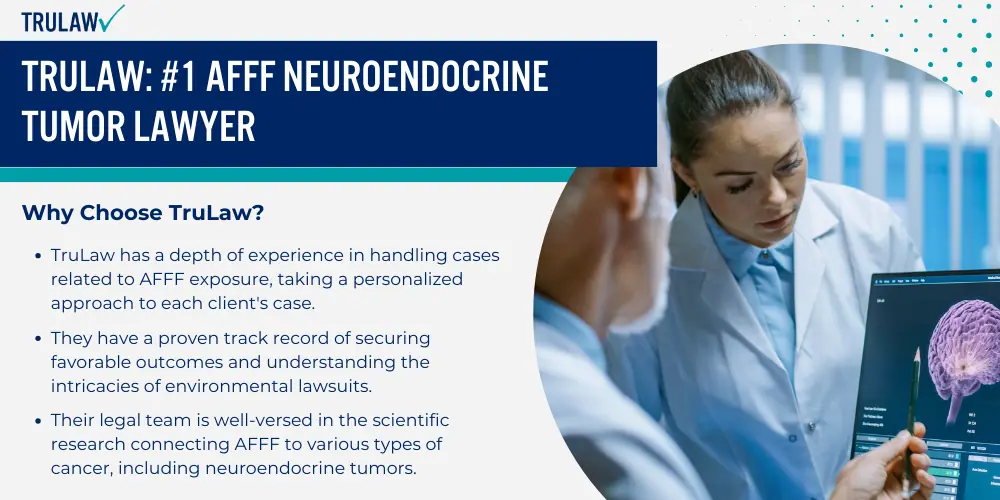
This firm has established itself as a principal advocate for victims exposed to aqueous film-forming foam (AFFF) who have subsequently developed neuroendocrine tumors.
Why Choose TruLaw?
- TruLaw has a depth of experience in handling cases related to AFFF exposure, taking a personalized approach to each client’s case.
- They have a proven track record of securing favorable outcomes and understanding the intricacies of environmental lawsuits.
- Their legal team is well-versed in the scientific research connecting AFFF to various types of cancer, including neuroendocrine tumors.
- TruLaw remains committed to providing transparent and clear legal counsel, ensuring that clients are fully informed throughout their legal journey.
Through meticulous research and a network of experts, TruLaw stands prepared to build a robust case for its clients.
They are equipped with best practice strategies proven to be effective in court.
Individuals who have developed health issues potentially linked to AFFF exposure and are considering legal action can receive a free case evaluation from TruLaw.
They can guide clients through the legal process with confidence and clarity.
With their support, many have found some measure of justice and compensation for the harm suffered due to potential negligence.
AFFF Lawsuit Frequently Asked Questions
-
Recent updates have shown that the litigation is progressing, with new filings and pretrial proceedings.
Interested parties can track the latest developments on the United States District Court website.
-
Eligibility to participate in the lawsuit typically requires a diagnosis of a neuroendocrine tumor and a history of exposure to AFFF products.
The specific criteria may be further outlined in case management orders.
-
Several law firms have developed a reputation for specializing in AFFF-related litigation.
Plaintiffs tend to opt for firms with a strong track record in environmental lawsuits and personal injury cases.
-
While settlements vary greatly based on the case specifics, compensation in similar toxic exposure lawsuits has ranged from moderate sums to multi-million-dollar awards, reflecting severity and liability.
-
The resolution or settlement dates for these lawsuits are not fixed and will depend on court schedules and the speed of legal proceedings.
Timeline updates can be found through official court documentation.
-
Prominent chemical companies that manufacture or sell AFFF products are typically listed as defendants.

Managing Attorney & Owner
With over 25 years of legal experience, Jessica Paluch-Hoerman is an Illinois lawyer, a CPA, and a mother of three. She spent the first decade of her career working as an international tax attorney at Deloitte.
In 2009, Jessie co-founded her own law firm with her husband – which has scaled to over 30 employees since its conception.
In 2016, Jessie founded TruLaw, which allows her to collaborate with attorneys and legal experts across the United States on a daily basis. This hypervaluable network of experts is what enables her to share the most reliable, accurate, and up-to-date legal information with our readers!
Additional AFFF Lawsuit resources on our website:
Here, at TruLaw, we’re committed to helping victims get the justice they deserve.
Alongside our partner law firms, we have successfully collected over $3 Billion in verdicts and settlements on behalf of injured individuals.
Would you like our help?
At TruLaw, we fiercely combat corporations that endanger individuals’ well-being. If you’ve suffered injuries and believe these well-funded entities should be held accountable, we’re here for you.
With TruLaw, you gain access to successful and seasoned lawyers who maximize your chances of success. Our lawyers invest in you—they do not receive a dime until your lawsuit reaches a successful resolution!
AFFF Lawsuit claims are being filed against manufacturers of aqueous film-forming foam (AFFF), commonly used in firefighting.
Claims allege that companies such as 3M, DuPont, and Tyco Fire Products failed to adequately warn users about the potential dangers of AFFF exposure — including increased risks of various cancers and diseases.
Depo Provera Lawsuit claims are being filed by individuals who allege they developed meningioma (a type of brain tumor) after receiving Depo-Provera birth control injections.
A 2024 study found that women using Depo-Provera for at least 1 year are five times more likely to develop meningioma brain tumors compared to those not using the drug.
Suboxone Tooth Decay Lawsuit claims are being filed against Indivior, the manufacturer of Suboxone, a medication used to treat opioid addiction.
Claims allege that Indivior failed to adequately warn users about the potential dangers of severe tooth decay and dental injuries associated with Suboxone’s sublingual film version.
Social Media Harm Lawsuits are being filed against social media companies for allegedly causing mental health issues in children and teens.
Claims allege that companies like Meta, Google, ByteDance, and Snap designed addictive platforms that led to anxiety, depression, and other mental health issues without adequately warning users or parents.
Transvaginal Mesh Lawsuits are being filed against manufacturers of transvaginal mesh products used to treat pelvic organ prolapse (POP) and stress urinary incontinence (SUI).
Claims allege that companies like Ethicon, C.R. Bard, and Boston Scientific failed to adequately warn about potential dangers — including erosion, pain, and infection.
Bair Hugger Warming Blanket Lawsuits involve claims against 3M — alleging their surgical warming blankets caused severe infections and complications (particularly in hip and knee replacement surgeries).
Plaintiffs claim 3M failed to warn about potential risks — despite knowing about increased risk of deep joint infections since 2011.
Baby Formula NEC Lawsuit claims are being filed against manufacturers of cow’s milk-based baby formula products.
Claims allege that companies like Abbott Laboratories (Similac) and Mead Johnson & Company (Enfamil) failed to warn about the increased risk of necrotizing enterocolitis (NEC) in premature infants.
Here, at TruLaw, we’re committed to helping victims get the justice they deserve.
Alongside our partner law firms, we have successfully collected over $3 Billion in verdicts and settlements on behalf of injured individuals.
Would you like our help?
